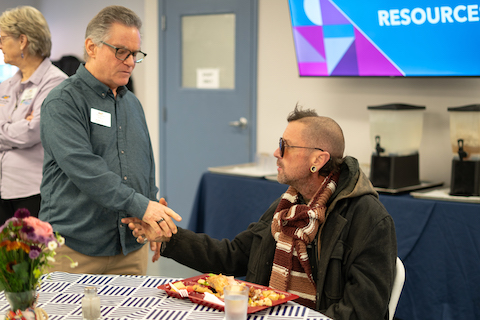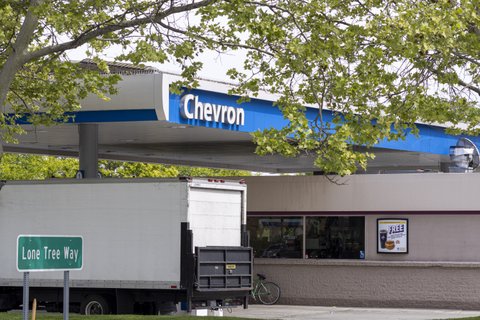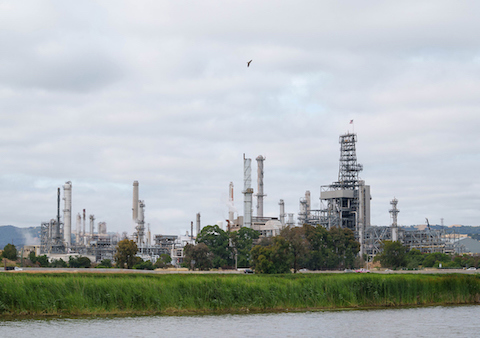
28 Jun Green Vision for Post-Petroleum Richmond Could Get Boost From Tax Measure

A man fishes from the jetty at Ford Channel in Richmond on April 22, 2024. (Ray Saint Germain via Bay City News)
By Ruth Dusseault
Bay City News
Picture a future where sail boats dock at the long wharf in Richmond, on the spot where tankers once delivered crude oil. Picture windmills on the south-facing hills, instead of petroleum tanks, generating renewable energy for the city with turbines manufactured by Richmond residents. Now, picture those projects seeded with a voter-approved tax on Chevron of $1 per barrel of oil processed at the refinery for the next 50 years.
Last week, the Richmond City Council voted unanimously to add the Oil Refining Business License Tax, dubbed the “Polluters Pay” measure, to the November ballot. If approved by voters, the potential $60 million to $90 million per year in tax revenue could propel the city’s Green-Blue New Deal, according to City Council member Gayle McLaughlin. She said the city hired a consultant for the deal, and the final plan will be reviewed in the next meeting Tuesday or right after the council reconvenes in September.
The Green-Blue New Deal is a resolution the city passed in July 2021. It’s a long-range vision plan for a post-petroleum Richmond. It was conceived in reference to the Green New Deal, proposed in Congress in 2019, which called for policies to address climate change while achieving other social aims like job creation, economic growth and reducing economic inequity.
At the core of Richmond’s 2021 version was a workforce development plan with an emphasis on environmental justice. The resolution acknowledged that “the city’s diverse working-class residents had suffered greatly over the last decade due to the Great Recession and the COVID-19 pandemic in terms of displacement, health impact and financial instability.”
“It basically states how we can get healthy sustainable jobs in the city, or green jobs,” said McLaughlin. “We have 32 miles of shoreline. Blue jobs would be water-related jobs, things like recreation or various sea level rise adaptive construction projects.”
The resolution called for the city to research a just transition to move away from a fossil fuel-based economy and toward a sustainable economy with sustainable jobs. It called for the city to “start negotiating with Chevron about reducing its refining capacity in a phased approach over a period of years with community compensation for harm done over 100+ years,” mentioning environmentally harmful incidents such as fires, explosions and oil spills.
Part of the resolution was to enact a public engagement process to “demonstrate the art of the possible.” In a creative outreach project by the environmental justice group Communities for a Better Environment, residents were asked to envision a post-petroleum Richmond.
The nonprofit worked with Marisol Cantú, an activist and third-generation Richmond resident. They produced a podcast, with which to survey a broad diversity of over 500 city residents.
“Our results showed that half of our participants had themselves or knew someone with a chronic respiratory illness or disease,” said Cantu. “We also asked, do you know anybody that worked at the Chevron refinery? And overwhelmingly, maybe 80%, said they knew nobody that worked at the refinery.”
Cantu said many community members talked about land sovereignty, giving land back to the Ohlone that once lived there. One woman talked about wanting to swim in the Bay, something she’d never done because she lived next to the refinery. Another person talked about art sculptures in the park and outdoor restaurants where they could sit at the port in the fresh air.
“They talked about uses for the land, including farming, greenery, parks, a skating rink, bicycles, all in this area. They talked about blue skies instead of smokestacks. They really saw the space as being wild. It was almost a complete opposite or juxtaposition of what it is now, which is gray with smoke, industrial,” said Cantu.
“They talked about having bowling alleys, daycare centers. They also talked about seeing water taxis moving around the bay and wind power coming off the bay or from the hills of that area, energizing our community in a green way. It was just freeing to them to realize that we could have this land and have it stewarded by the original people,” she said.
McLaughlin, who was a two-term mayor of Richmond before serving on the City Council, said she has asked Chevron for years to give her an estimate of how many of their employees live in Richmond.
“At one point it was 5% to 7% Another time they said 10%,” she said. “I think they may have said 15%, but we never got an accurate figure from them. I guess they don’t want to tell us.”
Richmond’s residents are mostly people of color. According to the U.S. Census from July 2023, the demographic composition of Richmond City is 44% Latinx, 18% Black and 14% Asian. Data from the California Environmental Protection Agency’s CalEnviroScreen tool shows Richmond residents experience a high burden from toxic releases from facilities. Some of the city’s census tracts have toxic release scores that rank among the highest 25% in the state of California.
Chevron has a long history of tax disputes with the city, McLaughlin explained.
“They do pay their utility tax. They actually have a special perk from going back to the ’90s, a cap with a cost of living increases each year. But it’s not what we think is enough. They also pay property tax, which they have tried to appeal repeatedly. And we rallied against that and, and we’ve won,” she said.
In 2020, the city placed a gross receipts tax for all businesses, said McLaughlin. Due to provisions in a previous legal settlement over taxes, in which Chevron paid $114 million over 15 years, the company was exempt from the gross receipts tax.
“This will be their last year on paying the settlement, and the last year of that exception,” said McLaughlin. “That is why the new tax is going to start, if the voters pass it, in July of 2025.”
Chevron was asked to verify these statements and to confirm how many of its employees actually live in the city of Richmond. A spokesperson for the company replied with an email statement.
“Chevron has been part of Richmond’s economic foundation, employing nearly 3,000 employees and contractors; supplying nearly 25% of the city’s general fund. We are deeply concerned that a small group of activists would destroy that legacy, employment base and the city’s financial future in a misguided tax grab,” the statement said.
“The proposal which has been floated by the city council would dramatically increase operating costs on one of three gasoline refineries left in the Bay Area. While it only applies within city limits, it would make the entire Bay Area less appealing to investment.”
Chevron said the new tax would cover nearly half of the city’s general fund.
“Increasing the reliance on one company and industry for city revenue is bad policy. The City of Richmond is playing chicken with the region’s economic future,” the statement said. “We urge the city council to avoid risking the viability of the city’s biggest taxpayer.”
Copyright © 2024 Bay City News, Inc. All rights reserved. Republication, rebroadcast or redistribution without the express written consent of Bay City News, Inc. is prohibited. Bay City News is a 24/7 news service covering the greater Bay Area.






No Comments